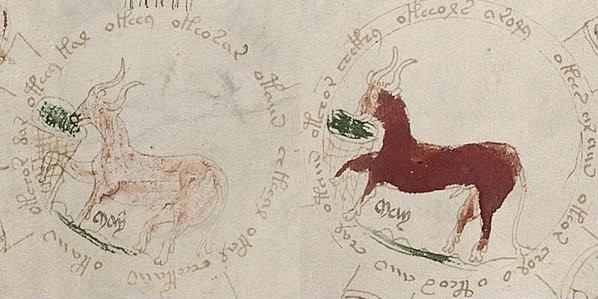
In Marco Ponzi’s extensive study of the Voynich Zodiac roundels, he describes Taurus in the following terms:
“The bull seems to be eating from a cylindrical manger, or drinking from a cylindrical well or bucket. It has been impossible to find any parallel for this detail. I think this point deserves further investigation.”
For a while now, I’ve been searching for something that might explain where the image of Taurus near a cylindrical manger might come from. I found nothing in astrological imagery. Even outside of zodiacs, most of the medieval images of bulls that I found represented them in nature, or interacting with other animals and people, or grazing in fields, or eating out of rectangular troughs. The cylindrical manger seemed elusive.
In this seasonally appropriate post, I will be exploring the possibility that the Voynich Taurus could be derived from the imagery of Nativity scenes. In Nativities, the round manger is a lot more common than in any other genre of medieval art. It is often represented as a structure made of wattle or some other type of basketry, which offers a compelling explanation for the criss-crossed pattern that is present on the manger in the Voynich image.
Bulls in Nativity scenes are most commonly portrayed near the manger where Jesus is laying, gazing upon him. Their position in the scene conveys either that they are adoring him (based on the 7th C Gospel of pseudo-Matthew) or that their breath keeps the baby warm (according to oral tradition).
There were variants of course, and medieval artists sometimes presented the bull as rather unconcerned with Jesus’ birth, or focusing on the food.
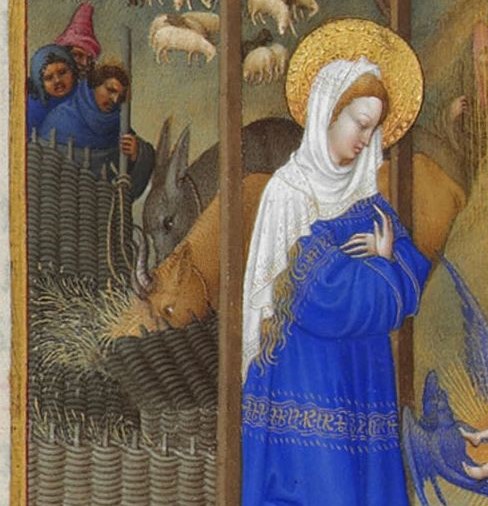
In most nativity imagery however, the bull is not portrayed eating, but rather looking on, with his head hovering just above a manger, usually the one Jesus is laying in, but not always.
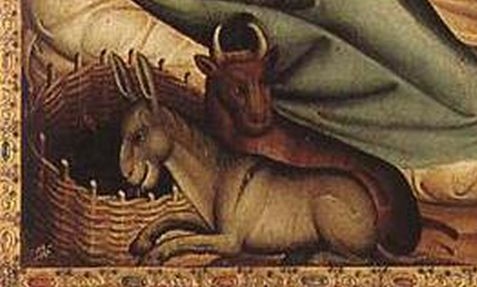
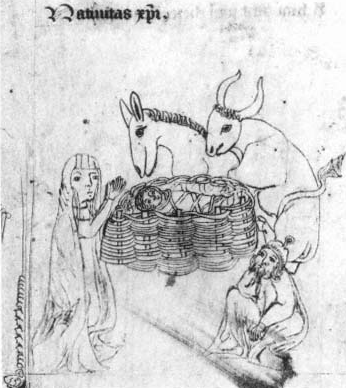

The bull with a round manger motif in Nativity imagery is found in many places, as these examples show. Geographically, this iconography alone cannot really help us to pinpoint a local tradition which the Voynich image would fit. Chronologically, however, the period is very restricted: all of the images I found were from the mid 14th to the mid 15th century. In this sense, the Voynich Taurus imagery appears to be firmly rooted in its time.
If the Voynich Taurus is based on Nativity imagery, this means that the period of production of the source material was very close to the time of production of the Voynich manuscript: the artist who created the Voynich zodiac roundels was inspired by recent or contemporary material, rather than by an older source.
How would Nativity imagery find its way into a Voynich zodiac roundel? In many medieval works, especially Books of Hours, Psalters, calendars and almanacs, both astrological imagery and biblical scenes can be found. In my opinion, the Taurus roundels could result from the presence of a Nativity in a book of Hours (or other such book) from which the Voynich artist drew his inspiration.
We don’t know what the Voynich text says, but some researchers have suggested that the human figures which surround the central roundels in the Zodiac section could have some relationship with the theme of fertility, pregnancy, or the cycle of life (for example, this one ). If this possibility is entertained, the use of a Taurus borrowed from a Nativity scene would be rather fitting.
EDIT: I want to highlight the importance of the references MarcoP left below. Here is a zoomed image of Vat. Gr. 1087, showing the Aselli:
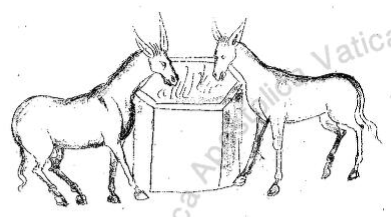
This image is very close to the nativity images I posted above, especially the Ethiopian example. It opens the possibility of a shift from Aselli to Taurus via the light and dark pair of the bull and donkey in Nativity scenes. But as MarcoP points out, this doesn’t account for the doubling of other signs in the Voynich, so we are still missing many pieces of the puzzle.
Edit: Another image of the Aselli from a Hyginus manuscript found by Marco Ponzi in a document compiled by Lippincott (see reference and link in the comments) :

Thank you for starting this interesting discussion, VViews!
The Zodiac signs have been partly Christianized in medieval times. Gemini as lovers often are clearly connected with Adam and Eve, the grazing ram with the sacrifice of Isaac, Virgo with the Virgin Mary and so on. See if you can read what Colum Hourihane wrote in her book (in particular about Gemini):
https://books.google.it/books?id=5IEuqbNeN30C
So, your idea that the manger could be connect with the Nativity seems sound to me. It is still possible (likely, in my opinion) that the image can be found in other zodiac cycles. We will see 🙂
A secondary detail that is not clear to me is why you wrote that, in nativity scenes, oxen “are always depicted as bulls”. An ox is a castrated bull, so the two are typically depicted identically and there is no way to tell one from the other, I think.
LikeLike
Hi MarcoP,
You are correct about the ox/bull thing, I will edit the post accordingly…
Also, thanks for the link to the Hourihane book! That will be my weekend read.
I hope we do find a zodiac cycle with a bull near a round manger one day… that would probably be a bit of a game-changer in terms of being able to place the Voynich zodiac, as it seems to be extremely rare!
LikeLike
Hi Voynichviews,
in her brief statement about the Voynich zodiac, Prof. Ewa Sniezynska-Stolot apparently linked the Taurus manger to the Praesepe (Manger) and Aselli (Asses) constellations. She wrote:
“From the astrological iconography point of view, the Taurus at a well is somewhat strange – unless an image of donkeys was a basis for it and then it would refer to Cancer – but that is certainly going too far”.
(her reference is not explicit, but since she mentions Cancer and Donkeys, I think this interpretation is likely correct)
http://voynich.net/Arch/2001/01/msg00024.html
A while ago Darren Worley mentioned the 11th Century Aberystwyth MS 735 C on the site of Stephen Bax:
https://stephenbax.net/?p=1682#comment-165172
https://www.llgc.org.uk/discover/digital-gallery/manuscripts/the-middle-ages/medieval-astronomy
If you navigate to img 9, you will see the first half of a celestial planisphere. The detail I want to point out is that the image of Cancer includes Aselli and Praesepe: two Asses eating from a Manger.
You will find details about Praesepe in Allen’s chapter about Cancer:
http://penelope.uchicago.edu/Thayer/E/Gazetteer/Topics/astronomy/_Texts/secondary/ALLSTA/Cancer*.html
In particular, he notes that Caesius mentioned the interpretation of the Manger as that of the Christ’s birth (“Coelum Astronomico-Poeticum”, 1662, p.63)
https://books.google.it/books?id=xJk5AAAAcAAJ&pg=PT74
LikeLiked by 1 person
Hi Marco P,
thank you for your comment, this is very interesting stuff and it took me a few days to process the info and take a look at the relationship between Aselli and Praesepe and Taurus.
Reading your comment, these latest developments give new promise to the possibility that Ewa Sniezynska-Stolot had dismissed as “going too far” about the Taurus iconography being connected to Cancer.
A few notes in reply:
The Manger cluster (Praesepe, aka M44, aka the Beehive, aka Little Cloud for Hipparchus or Little Mist for Aratus) has long been believed to share a common origin with another star cluster, the Hyades, which are in Taurus.
The best period for viewing the Manger cluster is between February and May, a period which includes the sign of Taurus: is the presence of the Manger in Taurus an illustration of the fact that this is a good time to observe the star cluster, or that this is when it is most influential? The period between February and May, during which the Manger is most prominent, also corresponds to the period during which the Voynich nymphs are in tubs, from Pisces to Taurus.
https://en.wikipedia.org/wiki/Beehive_Cluster
The Taurus-Cancer connection is possibly also suggested by the artist in that the two animals in the Voynich Cancer are light and dark like the Taurus and Aries pairs.
In spite of its Nativity influenced iconography, in astrological medicine the Manger/Praesepe’s influence appears to be strongly negative:
http://astrologyking.com/praesepe-star-cluster-m44/
As for the Aselli, they are also generally considered as a bad omen, with the exception that they are said to have favorable effects on astrological work itself.
http://astrologyking.com/asellus-australis-star/
I have not yet found any medieval images of these clusters outside of the example you showed… I’ll keep looking. Thanks for sharing the NLW MS image!
LikeLike
Hello Voynichviews,
I have found an illustration of Aselli and the Manger in ms BAV Vat.gr.1087 f302v.
http://digi.vatlib.it/view/MSS_Vat.gr.1087/309
It is an exceptional XV Century Byzantine manuscript. From what I understand, it is the only surviving exemplar of a Greek tradition of illustrated Eratosthenes manuscripts. It appears to be related in an unclear way to the Aberystwyth manuscript we previously discussed.
This page
Click to access Eratosthenes-Vat-grec-1087-pics-on-page-.pdf
quotes Weitzmann, “Roll and Codex”: “no other Greek manuscript with constellation illustrations is known”.
LikeLiked by 1 person
MarcoP thank you for this comment!
The Aselli illustration from Vat. Gr. 1087 is a real breakthrough and shows more commonalities with the Voynich Taurus roundels than any illustration I have seen so far.
The Aselli influence also would acount for the peculiar appearance of the Voynich bulls themselves.
The shift from bull to donkey might be explained via Nativity imagery, as we can see in the images in my post (and in others), the bull and donkey are often almost indistinguishable, with one typically dark and one light.
Your incredible find now leads me to wonder: did the Voynich artist base himself on an image of the Aselli to create a double Taurus, or are the “double Taurus” folios actually a depiction of the Aselli?
LikeLike
Hello Voynichviews, I am happy you find Vat.Gr.1087 interesting! Actually, I think this could be the most detailed medieval illustration of Aselli: it is possible that Ewa Sniezynska-Stolot was thinking of this specific image when she alluded to the donkeys as a basis for the Voynich Taurus illustration.
The 1933 essay by Panofsky and Saxl in which I found a reference to the ms dates it to the XV Century (fig.8).
https://www.jstor.org/stable/1522803
I read that recently the ms has been dated to 1350 ca: “Vat. gr. 1087, a manuscript of paper with watermarks produced between the 1320s and the 1330s in Constantinople under the guidance of the polymath Nicephorus Gregoras, most probably in the Monastery of the Chora”
http://bmcr.brynmawr.edu/2014/2014-09-12.html
I agree that this illustration is interesting in itself and as a parallel for the Voynich Taurus, but in my opinion some images are much closer than this one to the Voynich Taurus roundels. The Voynich bulls are part of a sequence in which they are followed by a couple of people, a crustacean, a feline, a woman, a pair of scales, etc: while it’s puzzling that there are two bulls, the presence of a bull in this position of the sequence is absolutely normal. Illustrations that make part of a series of roundels illustrating the same subjects seem to me the most relevant parallels. For example Cod.Sang.402
http://www.e-codices.unifr.ch/en/csg/0402/4/0/Sequence-527
or Cod. Pal. germ. 148 (which I think was first mentioned by Ellie Velinska):
http://digi.ub.uni-heidelberg.de/diglit/cpg148/0012
It is possible that there was contamination of Aselli and Taurus, maybe, as you suggest, through the Nativity theme. I also think that the caution with which Ewa Stolot proposed this idea is justified: the similarities are not enough to conclude with certainty in favor of an influence of Aselli on the Voynich Taurus. The duplication is clearly due to other reasons, as it involves Aries and Cancer as well. As you noticed, this phenomenon can be observed in other zodiac cycles, in particular Morgan M.700 (which, being more deviant than the Voynich zodiac, has no Taurus and duplicated Aries and Cancer):
https://stephenbax.net/?p=1755#comment-165331
I want to thank you again for this interesting post and I hope that other relevant images will come up in the future!
LikeLike
An addition to the list of Aselli images:
Kongelige Bibliotek, Ny kgl. S. 1812, f3r:
https://iconographic.warburg.sas.ac.uk/vpc/VPC_search/pdf_frame.php?image=00007403
I wish the whole manuscript was available online, but it seems the Warburg images are the only ones.
The MS is from the 14thC, Iceland.
LikeLike
Thank you, VViews! From the single page you linked, the manuscript seems totally compatible with other European works of that time: I would not have guessed it was from Iceland!
LikeLike
I agree about the look of the drawings. Apparently the monastery on Videy island, near Reykjavik, was connected to, and heavily influenced by, English monasteries. The GKS 1812 MS in particular is said to draw on Getty MS Ludwig XII 5, which also features Cancer with Aselli, although there’s only one donkey in that one: http://www.getty.edu/art/collection/objects/127868/unknown-maker-constellation-diagrams-english-early-13th-century/
LikeLike
More Aselli images in this collection by Kristen Lippincott. The one at the bottom of p.32, with “separate asini” might be of particular interest for us….
Click to access 00-Cancer-masterfile-15b-Jan-2017.pdf
LikeLike
What a wonderful resource document, and fantastic example of Aselli! I really like this one, thank you Marco!
I’ll add the illustration to the post.
LikeLike
Hi VViews,
in a recent blog post, Koen mentioned the collection of astronomical images on Kristen Lippincott’s site:
I found this 2006 paper a very interesting read:
Click to access 2006-Between-text-and-image-Mar-2016.pdf
Fig.32 presents a page from Stiftskirche ms 685: Pegasus is illustrated as eating from a bowl with a net-like pattern similar to that of Voynich “light” Taurus.
LikeLike
Thank you MarcoP!
The net pattern is indeed reminiscent of the Voynich Taurus basket design, and the proximity to an image of Aries is also worth noting.
I will have to look into this manuscript (Klosterneuberg 685). So far I can’t find a full digital copy, but several folios are available in digitized form here:
http://manuscripta.at/m1/hs_detail.php?ID=889
Aside from the illustration you noted, it also features a nice Cancer as crayfish and Leo with protruding tongue… but the other signs are different from those in the Voynich.
LikeLike
Thanks VViews, I hadn’t seen the other images! The diagram at 70v, with the Moon and Sun marking the Autumn and Summer equinoxes, is an interesting parallel for Voynich f68r2.
LikeLiked by 1 person